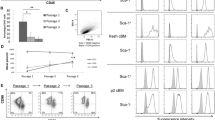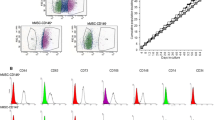Abstract
There is widespread interest in the use of bone marrow stromal cells (BMSC) for tissue reconstruction and repair and for gene therapy. BMSC represent the differentiated progeny of CFU-F, which however comprise a developmentally heterogeneous population as is reflected in the cellular heterogeneity of the cell populations to which they give rise. We have compared the efficacy of monoclonal antibodies recognising a series of stromal antigens, viz. STRO-1, HOP-26, CD49a and SB-10/CD166, as tools for the enrichment of CFU-F prior to culture and as developmental markers for culture-expanded BMSC. In freshly isolated bone marrow mononuclear cells (BMMNC), the proportion of antigen-positive cells was 27%, 46%, 5% and 19% for STRO-1, HOP-26, CD49a and CD166, respectively. All CD49a+ cells co-expressed STRO-1. The degree of CFU-F enrichment obtained with anti-CD49a (~18-fold) by a one-pass immunoselection strategy was significantly greater than that of all other antibodies tested. BMSC expressed higher levels of all antigens investigated (except for HOP-26) compared with BMMNC. Expression of STRO-1 and CD49a remained restricted to a subset of BMSC, whereas all BMSC were SB-10/CD166 positive. Treatment with dexamethasone (10 nM), which promotes the differentiation and further maturation of cells of the osteogenic lineage in this cell culture system, increased the expression of CD49a and HOP-26. The CD49a+ and HOP-26+ fractions of BMSC were further subdivided by dual-labelling with anti-STRO-1 and B4–78 (an antibody recognising the B/L/K isoform of the enzyme alkaline phosphatase), respectively. By using a variety of criteria, the HOP-26 antigen was identified as CD63, a member of the tetraspanin family of proteins thought to modulate integrin compartmentalisation and signalling.





Similar content being viewed by others
References
Barclay N, Birkeland ML, Brown MH, Beyers AD, Davis SJ, Samoza C, Williams AF (1993) The leukocyte antigen facts book. Academic Press, London San Diego
Berditchevski F (2001) Complexes of tetraspanins with integrins: more than meets the eye. J Cell Sci 114:4143–4151
Bianco P, Cossu G (1999) Uno, nessuno e centomila: searching for the identity of mesodermal progenitors. Exp Cell Res 251:257–263
Bianco P, Riminucci M, Gronthos S, Robey PG (2001) Bone marrow stromal stem cells: nature, biology, and potential applications. Stem Cells 19:180–192
Bruder SP, Fink DJ, Caplan AI (1994) Mesenchymal stem cells in bone development, bone repair, and skeletal regeneration therapy. J Cell Biochem 56:283–294
Bruder SP, Horowitz MC, Mosca JD, Haynesworth SE (1997) Monoclonal antibodies reactive with human osteogenic cell surface antigens. Bone 21:225–235
Bruder SP, Jaiswal N, Ricalton NS, Mosca JD, Kraus KH, Kadiyala S (1998a) Mesenchymal stem cells in osteobiology and applied bone regeneration. Clin Orthop Rel Res 355S:S247-S256
Bruder SP, Kraus KH, Goldberg VM, Kadiyala S (1998b) The effect of implants loaded with autologous mesenchymal stem cells on the healing of canine segmental bone defects. J Bone Joint Surg 80A:985–996
Bruder SP, Ricalton NS, Boynton RE, Connolly TJ, Jaiswal N, Zaia J, Barry FP (1998c) Mesenchymal stem cell surface antigen SB-10 corresponds to activated leukocyte cell adhesion molecule and is involved in osteogenic differentiation. J Bone Miner Res 13:655–663
Connolly JF (1998) Clinical use of marrow osteoprogenitor cells to stimulate osteogenesis. Clin Orthop Rel Res 355S:S257-S266
Deschaseaux F, Charbord P (2000) Human marrow stromal precursors are α1 intergrin subunit-positive. J Cell Physiol 184:319–325
Ferrari G, Cusella-De Angelis G, Coletta M, Paolucci E, Stornaiuolo A, Cossu G, Mavillo F (1998) Muscle regeneration by bone marrow-derived myogenic progenitors. Science 279:1528–1530
Friedenstein AJ (1980) Stromal mechanocytes of bone marrow: Cloning in vitro and retransplantation in vivo. In: Thiernfelder S (ed) Immunology of bone marrow transplantation. Springer, Berlin Heidelberg New York, pp 19–29
Friedenstein AJ, Piatetzky-Shapiro II, Petrakova KV (1966) Osteogenesis in transplants of bone marrow cells. J Embryol Exp Morphol 16:381–390
Friedenstein AJ, Chailakhjan RK, Lalikina KS (1970) The development of fibroblast colonies in monolayer cultures of guinea pig marrow and spleen cells. Cell Tissue Kinet 3:393–403
Friedenstein AJ, Chailakhjan RK, Gerasimov UV (1987) Bone marrow osteogenic stem cells: in vitro cultivation and transplantation in diffusion chambers. Cell Tissue Kinet 20:263–272
Gronthos S, Graves SE, Ohta S, Simmons PJ (1994) The STRO-1+ fraction of adult human bone marrow contains the osteogenic precursors. Blood 84:4164–4173
Gundle R, Beresford JN (1995) Isolation and culture of cells from explants of human trabecular bone. Calcif Tissue Int 56 (Suppl 1):S8–S10
Higginbottom A, Wilkinson I, McCullough B, Lanza F, Azorsa DO, Partridge LJ, Monk PN (2000) Antibody cross-linking of human CD9 and high-affinity immunoglobulin E receptor stimulates secretion from transfected rat basophilic leukaemia cells. Immunology 99:546–552
Horowitz EM, Prockop DJ, Fitzpatrick LA, Koo WWK, Gordon PL, Neel M, Sussman M, Orchard P, Marx JC, Pyeritz RE, Brenner MK (1999) Transplantability and therapeutic effects of bone marrow-derived mesenchymal cells in children with osteogenesis imperfecta. Nat Med 5:309–313
Horowitz EM, Prockop DJ, Gordon PL, Koo WWK, Fitzpatrick LA, Neel MD, McCarville ME, Orchard PJ, Pyeritz RE, Brenner MK (2001) Clinical responses to bone marrow transplantation in children with severe osteogenesis imperfecta. Blood 97:1227–1231
Jiang Y, Jahagirdar BN, Reinhardt RL, Schwartz RE, Keene CD, Ortiz-Gonzalez XR, Reyes M, Lenvik T, Lund T, Blackstad M, Du J, Aldrich S, Lisberg A, Low WC, Largaespada DA, Verfaillie CM (2002) Pluripotency of mesenchymal stem cells derived from adult marrow. Nature 418:41–49
Joyner CJ, Bennett A, Triffitt JT (1997) Identification and enrichment of human osteoprogenitor cells by using differentiation stage-specific monoclonal antibodies. Bone 21:1–6
Koc ON, Gerson SL, Cooper BW, Dyhouse SM, Haynesworth SE, Caplan AI, Lazarus HM (2000) Rapid hematopoietic recovery after coinfusion of autologous-blood stem cells and culture-expanded marrow mesenchymal stem cells in advanced breast cancer patients receiving high-dose chemotherapy. J Clin Oncol 18:307–316
Kon E, Muraglia A, Corsi A, Bianco P, Marcacci M, Martin I, Boyde A, Ruspantini I, Chistolini P, Rocca M, Giarino R, Cancedda R, Quarto R (2000) Autologous bone marrow stromal cells loaded onto porous hydroxyapatite ceramic accelerate bone repair in critical-size defects of sheep long bones. J Biomed Mater Res 49:328–337
Kopen GC, Prockop DJ, Phinney DG (1999) Marrow stromal cells migrate throughout forebrain and cerebellum, and they differentiate into astrocytes after injection into neonatal mouse brains. Proc Natl Acad Sci USA 96:10711–10716
Krebsbach PH, Mankani MH, Satomura K, Kuznetsov SA, Robey PG (1998) Repair of craniotomy defects using bone marrow stromal cells. Transplantation 66:1272–1278
Kuznetsov SA, Friedenstein AJ, Robey PG (1997a) Factors required for bone marrow stromal fibroblast colony formation in vitro. Br J Haematol 97:561–570
Kuznetsov SA, Krebsbach PH, Satomura K, Kerr J, Riminucci M, Benayahu D, Gehron Robey P (1997b) Single-colony derived strains of human marrow stromal fibroblasts form bone after transplantation in vivo. J Bone Miner Res 12:1335–1347
Lagasse E, Connors H, Al-Dhalimy M, Reitsma M, Dohse M, Osborne L, Wang X, Finegold M, Weissman IL, Grompe M (2000) Purified hematopoietic stem cells can differentiate into hepatocytes in vivo. Nat Med 6:1229–1234
Lawson GM, Katzmann JA, Kimlinger TK, O'Brien JF (1985) Isolation and preliminary characterization of a monoclonal antibody that interacts preferentially with the liver isoenzyme of human alkaline phosphatase. Clin Chem 31:381
Letchford J, Jefferiss C, Walsh S, Stewart K, Beresford JN (2001) Optimisation of selection procedures for the isolation of phage antibodies from STRO-1+ cell populations. J Bone Miner Res 16:P19
Makino S, Fukuda K, Miyoshi S, Konishi F, Kodama H, Pan J, Sano M, Takahashi T, Hori S, Abe H, Hata J-I, Umezawa A, Ogawa S (1999) Cardiomyocytes can be generated from marrow stromal cells in vitro. J Clin Invest 103:697–705
Mankani MH, Robey PG (1998) Transplantation of bone-forming cells. Endocrinologist 8:459–467
McCullough B, Peppa D, Monk PN, Skubitz KM, Partridge LJ (1996) A role for CD63 in signal transduction. Immunology 89 (Suppl 1):OM114
McMahon C, Will A, Hu P, Shah GN, Sly WS, Smith OP (2001) Bone marrow transplantation corrects osteoporosis in the carbonic anhydrase II deficiency syndrome. Blood 97:1947–1950
Metzelaar MJ, Wijngaard PLJ, Peters PJ, Sixman JJ, Nieuwenhuis HK, Clevers HC (1991) CD63 antigen: a novel lysosomal membrane glycoprotein, cloned by a screening procedure for intracellular antigens in eukaryotic cells. J Biol Chem 266:3239–3235
Mezey E, Chandross KJ, Harta G (2000) Turning blood into brain: cells bearing neuronal antigens generated in vivo from bone marrow. Science 290:1779–1782
Nilsson SK, Dooner MS, Weier H-U, Frenkel B, Lian JB, Stein GS, Quesenberry PJ (1999) Cells capable of bone production engraft from whole bone marrow transplants in nonablated mice. J Exp Med 189:729–734
Nomura H, Ishiguro T, Morimoto S (1969) Studies on L-ascorbic acid derivatives. III. Bis (L-ascorbic acid-3,3') phosphate and L-ascorbic acid 2-phosphate. Chem Pharm Bull 17:387–393
Oreffo ROC, Triffitt JT (1999) Future potentials for using osteogenic stem cells and biomaterials in orthopedics. Bone 25:5S–9S
Owen ME (1998) The marrow stromal cell system. In: Beresford JN, Owen ME (eds) Marrow stromal cell culture. Cambridge University Press, Cambridge, pp 1–9
Petite H, Viateau V, Bensaid W, Meunier A, Pollak C de, Bourguignon M, Oudina K, Sedel L, Guillemin G (2000) Tissue-engineered bone regeneration. Nat Biotech 18:959–963
Phinney DG, Kopen G, Isaacson RL, Prockop DJ (1999) Plastic adherent stromal cells from the bone marrow of commonly used strains of inbred mice: variations in yield, growth, and differentiation. J Cell Biochem 72:570-585
Scutt A, Bertram P (1999) Basic fibroblast growth factor in the presence of dexamethasone stimulates colony formation, expansion, and osteoblastic differentiation by rat bone marrow stromal cells. Calcif Tissue Int 64:69–77
Simmons PJ, Torok-Storb B (1991) Identification of stromal cell precursors in human bone marrow by a novel monoclonal antibody, STRO-1. Blood 78:55–62
Smith DA, Monk PA, Partridge LJ (1995) Antibodies against human CD63 activate transfected rat basophilic leukemia (RBL-2H3) cells. Mol Immunol 32:1339–1344
Stewart K, Gronthos S, Simmons PJ, Beresford JN (1996) H8G—a monoclonal antibody that subtypes the STRO-1+ CFU-F population of human bone and marrow. J Bone Miner Res 11:P19
Stewart K, Jefferiss C, Screen J, Walsh S, Beresford JN (1998) The identification and isolation of cells of the osteoblastic lineage in cultures of adult human bone-derived cells by dual labeling with monoclonal antibodies STRO-1 and B4–78. In: Russell RGG, Skerry TM, Kollenkirchen U (eds) Ernst Schering Research Foundation Workshop 25: novel approaches to treatment of osteoporosis. Springer, Berlin Heidelberg New York, pp 43–60
Stewart K, Walsh S, Screen J, Jefferiss C, Chainey J, Jordan GR, Beresford JN (1999) Further characterisation of cells expressing STRO-1 in cultures of adult human bone marrow stromal cells. J Bone Miner Res 14:1345–1356
Stewart K, Gronthos S, Bord S, Zannettino A, Simmons P, Beresford JN (2001) Further characterisation and molecular cloning of the antibody H8G. J Bone Miner Res 16:P14
Walsh S, Jefferiss C, Stewart K, Jordan GR, Screen J, Beresford JN (2000) Expression of the developmental markers STRO-1 and alkaline phosphatase in cultures of human marrow stromal cells: regulation by fibroblast growth factor (FGF)-2 and relationship to the expression of FGF receptors 1–4. Bone 27:185–195
Walsh S, Jordan GR, Jefferiss C, Stewart K, Beresford JN (2001) High concentrations of dexamethasone suppress the proliferation but not the differentiation or further maturation of osteoblast precursors in vitro: relevance to glucocorticoid-induced osteoporosis. Rheumatology 40:74–83
Woodbury D, Schwarz EJ, Prockop DJ (2000) Adult rat brain and human bone marrow stromal cells differentiate into neurons. J Neurosci Res 61:364–370
Yoo JU, Johnstone B (1998) The role of osteochondral progenitor cells in fracture repair. Clin Orthop Rel Res 355S:S73-S81
Zannettino ACW, Harrison K, Joyner CJ, Triffitt JT, Simmons PJ (2003) Molecular cloning of the cell surface antigen identified by the osteoprogenitor-specific monoclonal antibody, HOP-26. J Cell Biochem 89:56–66
Acknowledgements
The authors are grateful to the surgeons and theatre staff at The Royal Devon and Exeter Hospital, Exeter, without whom this work would not have been possible.
Author information
Authors and Affiliations
Corresponding author
Additional information
K.S., S.W., C.M.J. and J.A.L. gratefully acknowledge the financial support of the University Bath, the Arthritis Research Campaign and the Wellcome Trust
Rights and permissions
About this article
Cite this article
Stewart, K., Monk, P., Walsh, S. et al. STRO-1, HOP-26 (CD63), CD49a and SB-10 (CD166) as markers of primitive human marrow stromal cells and their more differentiated progeny: a comparative investigation in vitro. Cell Tissue Res 313, 281–290 (2003). https://doi.org/10.1007/s00441-003-0762-9
Received:
Accepted:
Published:
Issue Date:
DOI: https://doi.org/10.1007/s00441-003-0762-9




